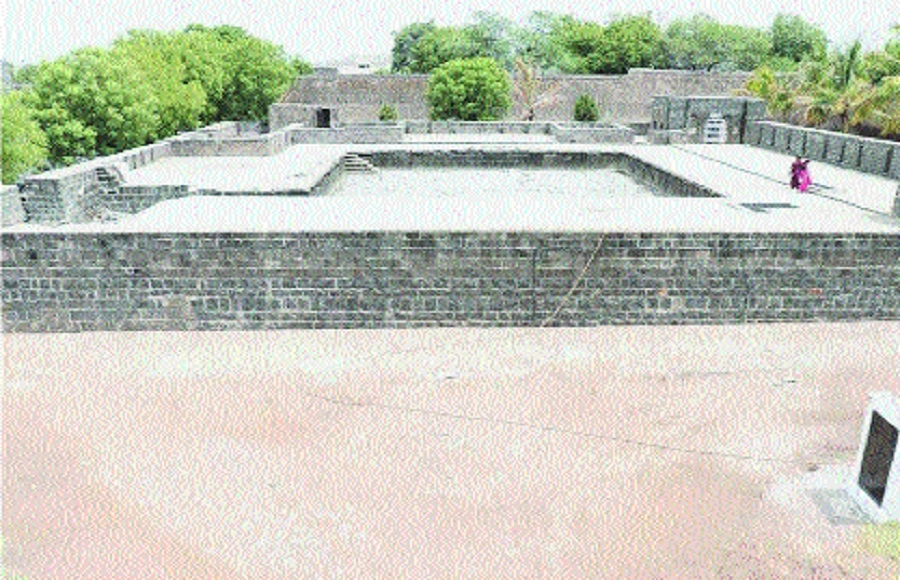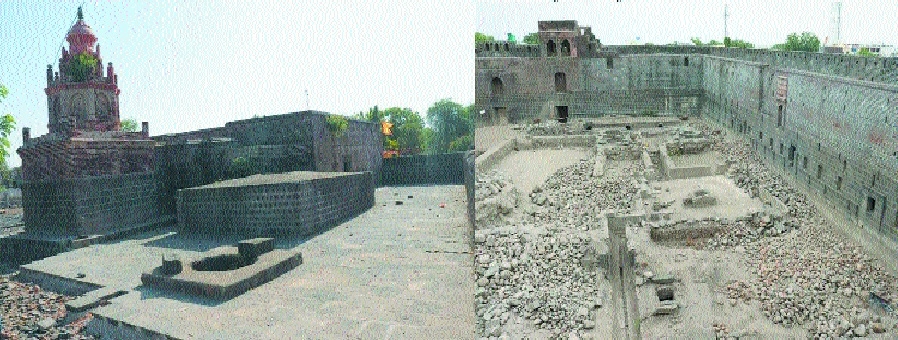Rejuvenation work of Jijamata’s birth place nears completion
| Date :03-Sep-2019 |

Lakhuji Raje Jadhav Palace almost rejuvenated by conservationists Department of Archaeology & Museums, Government of Maharashtra.
By Shirish Borkar :
The Department of Archaeology and Museums has undertaken the Rs 12.95 crore conservation work of five historical monuments at Sindkhedraja in Buldana district of Vidarbha on scientific lines with funds support from State Government
THE hitherto sidelined birth place of Rajmata Jijausaheb, mother of Chhatrapati Shivaji Maharaj, in Sindkhedraja is undergoing rejuvenation, thanks to the initiative taken by the Department of Archaeology & Museums of Maharashtra Government. The State Government, too, has done its bit for the cause by giving the necessary funds support for undertaking the work. Custodian of cultural heritage of Maharashtra, Department of Archaeology and Museums has undertaken conservation work of five historical monuments at Sindkhedraja in Buldana district of Vidarbha on scientific lines.
 (left ) Nilkantheswar Mandir in Sindkhedraja. (right ) Conservation work at Sawkarwada.
(left ) Nilkantheswar Mandir in Sindkhedraja. (right ) Conservation work at Sawkarwada.With State Government sanctioning the funds for development of Sindkhedraja, the experts from the Department of Archaeology and Museums started executing the Rs 12.95 crore conservation work at Lakhuji Raje Jadhav Rajwada, Sawkarwada, Kalakot, Rang Mahal and Neelkantheshwar Mandir. Lakhuji Raje Jadhav was a grandee of Sindkhedraja during 16th Century. He was ‘Panchhajari Mansabdar’ of the Nizams. In 1576, Lakhuji Raje Jadhav settled in Sindkhedraja. Jijamata was born to him on January 12, 1598, in his palace. The entrance of palace in north direction is made of stone. Coconut pylons are main attraction of this entrance. The three floor entrance is having ‘Devdaya’ on ground floor, ‘Nakarkhana’ on the first floor with a security wall.
After the entrance, is a square stone foundation which may have been used for accommodation. There is an underground house along with ventilation below the foundation. Dr Virag Sontakke, Assistant Director, Department of State Archaeology and Curator of Central Museum Nagpur, Government of Maharashtra, told ‘The Hitavada’ that conservation, preservation and restoration work of Lakhuji Raje Jadhav Rajwada was almost complete. “The conservation and restoration work of Sawkarwada, Kalakot, Rang Mahal and Neelkantheshwar Mandir is in progress,” he added. Rang Mahal is place where Jijausaheb had played ‘Holi’. It is close to the palace. Rang Mahal is the place where Shahaji Raje had seen Jijabai playing ‘Holi’ before their marriage. Neelkantheshwar Mandir, which dates back to 8th-10th Century, has an inscription of Lakhujirao Jadhav for revival of the temple. In front of this Hemadpanti style temple, there is a massive bar arranged by stairs to the bottom of the square.
The temple’s entrance is facing east and it is divided into Mandapa and Shrine. Similarly, Kalkot fort also belongs to the period of Rajerao Jagadeorao Jadhav. The walls are 20 ft in width and 20 ft in height. In addition to this, there is a 40-foot-tall walled fort called Sachkarwada, which can be seen on an intersection, there are internal roads, wells, sub-basement and subway. Dr Sontakke, who was supervising the conservation work, informed that the cemented portions of some of these monuments including Rang Mahal have been removed and replaced with original material to give these historic edifices a grandeur look. The flooring of Neelkantheshwar Mandir has been replaced with stone tiles, he added.
“We are strictly adhering to the standards and conservation norms while executing the work,” said Dr Sontakke who has been transferred to Nashik recently in the same capacity. Similarly, Sawkarwada is associated with important persons and money lenders. Main entrance of Sawkarwada is on the eastern side. The sub-entrance is in south direction. Outer side of main entrance is decorated by geometrical designs. This palace is surrounded by parapet wall along with the place for gun point.





